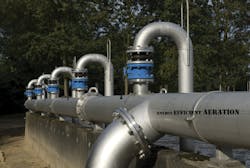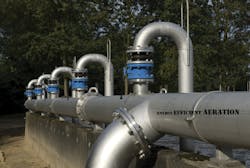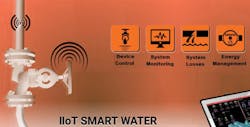Leveraging IIoT for Energy Management
Incorporating the Industrial Internet of Things can enable direct energy savings for the smart water utility of today
By Anil Gosine
Growing scarcity of freshwater resources, growth in urban population, environmental regulations and process inefficiencies are all contributing to a dilemma in the water and wastewater industry. It is estimated that the amount of energy wasted as a result of traditional methods of water processing and delivery can be reduced by up to 25 percent. Energy consumption at a typical municipality in the United States is distributed through various departments, with a majority of the energy consumption attributed to the water/wastewater facilities. With the volatility of energy prices, a need to improve sustainability, continual changes in legislation and increased instances of funding available for energy efficiency initiatives, there is now greater opportunity to improve energy and operation efficiency at these industrial facilities.
Many utilities have initiatives that are focused on saving energy through the use of motion-sensitive, energy-efficient lights, limited-time use of HVAC systems, solar panel installations (primarily based on electric utility grants), energy efficient devices and system-wide collaboration of storage through reservoirs. These actions focus on the Overall Equipment Effectiveness (OEE) of the facility rather than directly affecting energy conservation; rather, energy conservation is a byproduct of these efforts. Incorporating the Industrial Internet of Things (IIoT), in contrast, can enable direct energy savings for the smart utility of today.
With IIoT, engineering analyses can occur on the additional real-time data from remote systems, motors and other larger energy-consuming equipment.
Disruptive technologies are emerging at an unprecedented rate and it is difficult to know which technologies offer genuine savings versus those that are likely to be rendered obsolete before they achieve their potential. It is challenging for organizations to decipher the hype and identify those technologies that are applicable to their needs and can deliver an immediate positive return on investment.
Within this utility sector, the benefits of IIoT applications are slowly being piloted to create new value in information about elements of business processes that manage existing assets for increased reliability, optimization, supply chains and customer relationships. The IIoT solutions available allow integration of sensing, communications, SCADA and analytics capabilities that have been emerging over recent years. With the increase in pervasive computing devices, lower cost sensors that collect and transmit data, new analytic tools and economic data storage options, a utility can capture more data in real time at a lower cost and, in some cases, from previously inaccessible areas that improves field, system and plant performance.
In order to deliver on the potential of IIoT, however, system professionals must design the architecture to ensure that:
• Operators are empowered. The use of mobile devices, cloud connectivity and data analytics provide operators real-time information for better decision making.
• Assets are optimized. Smart sensors continue the flow of information and allow for data to be easily collected from the field and from parameters previously unmeasured.
• It’s smart-control aided. Enabling tight integration between operational and informational technology for better decision making in the wider enterprise.
• It’s cybersecurity focused. More connectivity demands an increased awareness and posture through an OT cybersecurity solution in addition to the available IT security deployment.
To enable energy efficiency at utilities, IIoT should be implemented so that engineering analyses can occur on the additional real-time data from remote systems, motors and other larger energy-consuming equipment, which makes analysis quick, straightforward, and more accurate. IIoT strengthens the capabilities for real-time alerts, providing the ability to predict energy demand, usage patterns, and ways to optimize energy consumption when integrated with industrial control systems data sets.
Energy efficiency is becoming an issue that many utility owners are focusing on. It is estimated that a majority of pump systems are oversized, some by more than 20 percent. With electricity costs accounting for 40 percent of the total cost of ownership (TCO) of a pump, managing the energy of this asset is key. The solution for these issues can be found in intelligent pumping, which incorporates IIoT. This approach results in lower energy usage, increased equipment lifetime, and maintenance cost reductions by providing higher-quality and more precise data.
One major source of electricity usage in water/wastewater facilities involves the pumping and aeration equipment systems. Implementing a data-driven framework for improving the performance of water/wastewater pumping systems has been realized using data science techniques, modeling, leveraging IIoT technology and computational intelligence. A pump system’s performance is measured in energy consumption and pumped water/wastewater flow rate. Many pumps typically operate below their best efficiency point (BEP), resulting in excess energy being transmitted into vibration, heat and noise — all of which increase maintenance and energy costs. When equipment is not optimized for best efficiency, pump systems consume maintenance budgets by decreasing the mean time between repairs. Organizations must focus on total life cycle cost (LCC) instead of initial purchase price.
Peter Gabor,Business Development Director for Emerson’s Power & Water Solutions business, provided his perspective on customers’ views on IIoT and energy management.
Q: What is the primary goal that energy management addresses in your water or wastewater customers’ minds?
Peter Gabor: O&M costs continue to increase year over year, straining customers’ budgets. With energy costs comprising a large portion of their overall costs, the intent is to offset a percentage of cost increases through reduced energy consumption.
Q: Is this driven by informational needs or is data to be correlated directly with costs and rate structure?
PG: Both. We’ve seen the need to understand the largest-consuming assets and then determine the poorest-performing assets. Depending on our customer’s purchase agreement, peak load shaving is an attractive area that’s been investigated and utilized over the years. Oftentimes it’s not only the direct cost of energy usage that is of value but also the impact that incoming power quality has on the reliability of assets.
Q: Is there an upfront understanding by operations of how their facility is billed by the power utility?
PG: Frequently not throughout the organization. Although, it does vary based on the complexity of the agreement with the power producer and how well the staff is informed of the agreement. Unless energy usage is a line item on an individual’s budget or a metric by which they are evaluated, it often takes a back seat to more evident pressing needs.
Q: Are customer efforts targeted toward identifying the energy usage by motor control center (MCC), process or individual equipment?
PG: All three. For energy usage we often recommend customers start at the incoming power source and work toward the individual assets. Monitoring switchgear is often the easiest as most equipment has this information readily available, but it provides no granularity of the downstream devices being powered. Monitoring individual equipment provides the visibility on usage and efficiency degradation over time. However, there is a cutoff point where smaller individual equipment is just too difficult to justify the expense to monitor — although that cut-off is lowered due to IIoT. The approach that has worked best for us and our customers is to look at the entire process in conjunction with an asset’s energy usage as they are often correlated.
Q: What is the customer approach to make IIoT data beneficial and who is the target audience?
PG: The data needs to be presented to the individuals who have the responsibility to act on it. Right now, we often see them pulling in the data just to monitor and there is no context to it. However, these systems tend to be disjointed and require a better understanding of how the operation of the equipment impacts the reliability of the equipment and efficiency of the process. Operations, maintenance, and energy managers who have responsibility over the energy budget can all benefit from this information.
IIoT strengthens the capabilities for real-time alerts, ability to predict energy demand, usage patterns, and ways to optimize energy consumption when integrated with industrial control systems data sets.
Q: Are there typically baselines that capture the company policy, accountabilities, investment decision making and internal organization related to energy management?
PG: Yes, without a baseline there is nothing to compare against to measure improvement or degradation. The metrics vary and often have to be tailored to the initiatives of the organization, but providing reliable data when needed has empowered them to make informed decisions about their assets.
Q: How should the customer’s control system and IIoT interact/integrate to provide maximum benefit?
PG: Bringing the data into one central location paves the way for information sharing, data analytics, performance monitoring, and optimization. Cybersecurity should be at the forefront to ensure the data feed is reliable. Once the connection is protected, then the data quality and accurate time stamping of the data received should be considered, which includes verifying the reliability and accuracy of the instrumentation installed. Key performance indicators (KPI) and actionable information can then be presented to management to understand the impact on equipment usage and also to operations to potentially modify their behavior to reduce energy consumption. With this framework in place, process optimization can be realized and compared against baseline metrics using the KPIs developed.
Q: What does IIoT mean to most of your customers?
PG: It applies to any monitoring equipment with an IP address and comprises the ability to read in periodic data through geographically dispersed locations economically to enable an enterprise data management system. IIoT poses a potential vector for unwanted access, though. Cybersecurity solutions need to be considered.
Q: Does IIoT provide an avenue to replace traditional remote monitoring sites that have significant upfront costs?
PG: At an individual transmitter level, yes, as the cost of installation is more attractive. From a traditional metering or pumping station, communicating to a central facility is not new. We are seeing communication technologies in this area provide a more reliable data feed with redundant data paths. We see IIOT enabling more geographically dispersed instrumentation with a few IO where previously only large clusters of instrumentation were economically feasible.
Combining IIoT, automation and energy management initiatives, we can provide the water utility industry an historic future. With IIoT sensors now offering a substantially cheaper price point with new battery-powered networking solutions, the price barrier has been significantly reduced. Cutting-edge IIoT water solutions are gaining traction with private and municipal water utilities, which see data and analytics as critical tools for overcoming the issue of aging water infrastructure.
The ability to interconnect things, services and people via the Internet improves data analysis, increases productivity, enhances reliability, saves energy and costs, and generates new revenue opportunities through innovative business models. IIoT and the cloud services that support this ecosystem also offer the benefit of bringing world-class analytics within reach of smaller facilities.
Conversely, efficiencies driven by increased IIoT-based remote monitoring and control also expose water systems to cyber attacks or hacks, which could affect delivery. As water and wastewater operations leverage new technologies, there must be an increased focus on using secure and reliable wireless networking technology, anomaly detection and redesigned system architecture. WW
About the Author: Anil Gosine is chair of the Strategic Efficiency Consortium — Security and Optimization Workgroup. Gosine has over 19 years of construction management, operations and engineering experience within the industrial sector with primary focus on electrical, instrumentation and automation in U.S., Canada and Central America. Previously, he managed the department-wide industrial control system (ICS) for the Detroit Water & Sewerage Department. Gosine is an active member of several professional organizations, participates in industry forums and technical committees, and leads the SEC Workgroup.
Circle No. 242 on Reader Service Card


